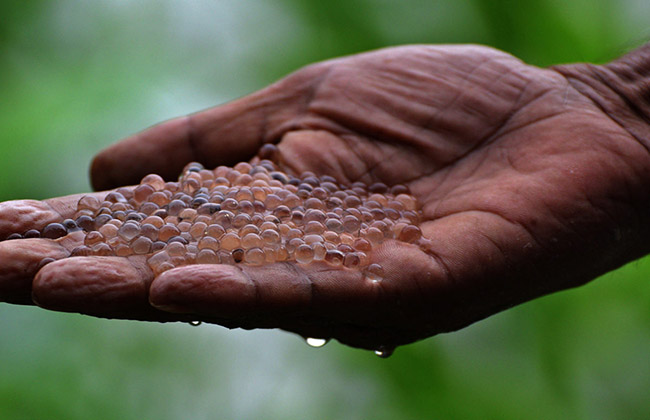
The Halda River — the world’s only gene bank for pure Indian carp fishes such as ruhi (Labeo rohita), catla (Labeo catla), Mrigal (Cirrhinus cirrhosus) and Kalibaush (Labeo calbasu) — has resumed hosting fish eggs in recent years, after fish eggs had all but disappeared from the river in 2016.
At its height in 1941, around 4,000 kgs (8,818 lbs) of fish eggs could be found in the river, according to the Halda River Research Laboratory at the Zoology Department of the University of Chittagong. The river is also home to around 147 Ganges River dolphins, which have been categorized as endangered by the International Union for Conservation of Nature (IUCN).
In 2020, 424 kg (935 lbs) of fish eggs were produced in the river, although production fell in the last two years due to salinity intrusion as a result of an unexpected tropical cyclone named Amphan.
Since 2018, comprehensive conservation efforts to rein in overfishing, industrial pollution and other pollutants such as tobacco farming, spearheaded by the government and civil society, have allowed fish to once again breed in the Halda’s waters.
The government also initiated a process to declare the river an Ecologically Critical Area (ECA), which, experts say, will further protect the river — source to about 180 million liters (47.5 million gallons) of fresh water for about 7 million inhabitants of Chittagong city. In 2020, the river was declared a fish heritage site.
In 2018, the Department of Environment surveyed the river to uncover the reasons behind the death of aquatic species across the water body.
In its survey report, the department blamed the huge discharge of industrial waste as one of the major causes of river pollution. The pollution can be reduced if the river can be brought under ECA guidelines, the report suggested.
About 20 to 25 factories, including a tannery, dyeing plant, paper mill and power generation plant are located on the banks of the Halda.
“Two major polluting factories — Asian Paper Mills and the 100-MW peaking power plant — have been shut down for the last three years as part of conservation initiatives, which ultimately reduced pollution by half,” said Md Manzoorul Kibria, professor of zoology at the University of Chittagong, also head of the Halda River Research Laboratory.
Guards have also been deployed across a 20-kilometer-long (12.4-mile-long) stretch (Sartar Khāl to Kalurghat) of the river — considered a breeding ground — to stop indiscriminate fishing. In addition, farming and tanning of tobacco in areas adjacent to the Halda River have also been stopped for more than a year.
Ecologically Critical Area
An Ecologically Critical Area is defined as an area that is unique in biodiversity and presently in a sorry state due to different human interventions. Therefore, it needs to be protected from further degradation.
In 1999, the Bangladesh government formulated the Ecologically Critical Area Rules to protect special areas that are under threat. Currently, there are 13 ECAs across Bangladesh.
To restore the Halda, the environment department issued a draft gazette on March 31, 2018, to bring the river under ECA status and solicited feedback from the related stakeholders.
“We were trying to declare the Halda an ECA since 2018 but facing difficulties to finalize the boundary of the river,” said M Rafiqul Islam, a deputy director of the Department of Environment.
The plan is to declare the 107-kilometer-long (665-mile-long) strip of the Halda River, from its origin at Ramgarh Upazila of Khagrachari district to the confluence of the Karnaphuli River at Chittagong district, as an ecologically protected area.
The Center for Environmental and Geographical Information Services (CEGIS) has worked to digitize the 500-meter (1,640-foot) area on both sides of the river, which was essential to demarcating the total area of the river.
“After getting the digitized version of the detailed area of the river and its adjacent areas from CEGIS, we have recently sent the application to the Ministry of Environment, Forest and Climate Change,” Islam said, adding that the declaration now depends on the ministry’s decision.
Terming the government’s initiative “urgent,” Syeda Rizwana Hasan, chief executive of the Bangladesh Environmental Lawyers Association (BELA), said “declaring the river ECA will create at least an obligation to not pollute the river.”
However, the government has so far failed to conserve the existing ECAs, as only piecemeal measures are visible in important ecological habitats of Saint Martin’s Island, Hakaluki Haor, Cox’s Bazar and Sonadia Island.
While the process of ECA declaration is ongoing, the government declared the river a fish heritage in 2020 to express the importance of the river and its biodiversity under the Biological Diversity Act 2017.
Existing ECAs in Bangladesh
1. Sundarbans, the single largest mangrove forest on earth, which is also a Ramsar site
2. Cox’s Bazar sea beach, 152 km (94.4 mi) long, the single largest sea beach on earth
3. Saint Martin’s Island, habitat of rare types of coral reef
4. Sonadia Island, which serves as breeding ground of marine turtles
5. Tanguar Haor, a marshland and important natural habitat for mother fish breeding, which is also a Ramsar site
6. Hakaluki Haor, a marshland that is very important for mother fish breeding and swamp forest
7. Buriganga, Turag, Balu and Shitalaksha — the four rivers surrounding the country’s capital city, Dhaka
8. Gulshan Baridhara Lake, situated in the heart of the capital city
9. Marjat Baor, a marshland, which is also very important as a breeding place of mother fish stock
10. Piyain River at Jaflong
(This article is republished from Mongabay under Creative Commons License)
Abu Siddique is Mongabay’s Contributing Editor for Bangladesh. He has worked for several of the leading national dailies including Dhaka Tribune, Daily Sun and The Business Standard, and has explored the remotest corners of the country in search of stories.


